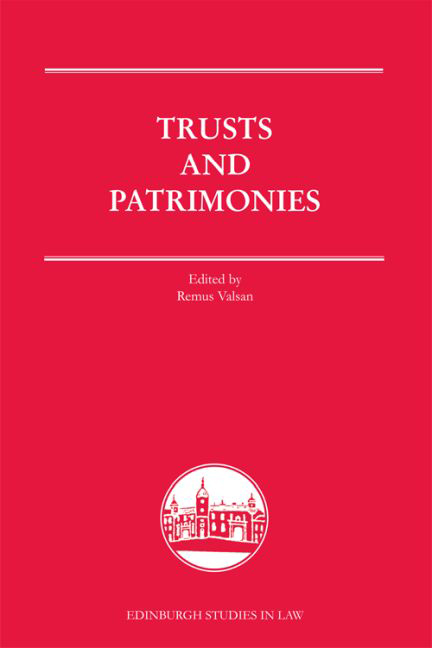Book contents
- Frontmatter
- Contents
- Preface and Acknowledgements
- List of Contributors
- List of Abbreviations
- Table of Cases
- INTRODUCTION
- 1 The Trust as Patrimony: An Introduction
- PART I PATRIMONY AND THE COMMON LAW TRUST
- PART II PATRIMONY AND THE SCOTTISH TRUST
- PART III TRUST AND PATRIMONY IN FRANCE, QUEBEC AND THE NETHERLANDS
- Index
1 - The Trust as Patrimony: An Introduction
from INTRODUCTION
Published online by Cambridge University Press: 15 September 2017
- Frontmatter
- Contents
- Preface and Acknowledgements
- List of Contributors
- List of Abbreviations
- Table of Cases
- INTRODUCTION
- 1 The Trust as Patrimony: An Introduction
- PART I PATRIMONY AND THE COMMON LAW TRUST
- PART II PATRIMONY AND THE SCOTTISH TRUST
- PART III TRUST AND PATRIMONY IN FRANCE, QUEBEC AND THE NETHERLANDS
- Index
Summary
Trusts exist in a multitude of forms across legal systems and traditions. This diversity of instruments makes it remarkably difficult to give a straightforward answer to a simple question: what is a trust? This volume does not purport to find a definitive answer to this thorny question. It aims, instead, to explore potential answers using the patrimony as the main conceptual tool. Before addressing the problem of defining the trust from a comparative private law angle, however, a more fundamental question needs to be given some consideration: why do we need to search for, and pin down, a common denominator for the broad spectrum of trusts and trust-like institutions? Can supra-national and system-neutral legal institutions exist? These are inveterate dilemmas of comparative law.
The First International Congress of Comparative Law held in Paris at the dawn of the twentieth century was one of the many forums in which these questions have been debated over the years. Andre Weiss, a Parisian law professor and member of the French Academy of Moral and Political Sciences, was among the most virulent opponents of the idea of shared supra-national legal institutions. There are historical, commercial, religious and moral reasons, Weiss pointed out, why nations have different laws. Legal uniformity is a “dangerous chimera” that disregards the diversity of contexts and social institutions. Another participant to the Congress, the illustrious French jurist Raymond Saleilles, believed the contrary. Any profound comparative study of laws and legal institutions, Saleilles wrote, reveals that legal systems do not progress on parallel tracks. They share many points of contact and their progress is fuelled by constant cross-fertilisation. Saleilles believed that this insight should be an impetus to give the comparative law the role of a science that, following the steps of history and sociology, should aim to identify common fundamental processes that regulate life across human societies.
In order to fuel the legislative progress and the converging trend of national legal systems, Saleilles further observed, the comparative law should operate at three levels. First, it should observe and analyse national legal institutions in the economic and social context in which they developed. Second, it should seek commonalities and points of contact that indicate common trends in the evolution of these analogous legal institutions. Third, it should identify an ideal jural model (type idéal) towards which the existing analogous institutions should channel their developments.
- Type
- Chapter
- Information
- Trusts and Patrimonies , pp. 3 - 10Publisher: Edinburgh University PressPrint publication year: 2015



